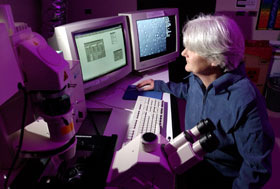Scientists, Mathematicians Work Together
To Advance Cell Biology
 |
| Ann Cowan, associate professor of molecular, microbial, and structural biology, helped organize a conference to encourage collaboration between empirical scientists and theoretical mathematicians. |
|
Photo by Peter Morenus |
The UConn Health Center is building a new scientific community to mine and manipulate the explosion in basic scientific knowledge provided by advances in molecular biology and genomics, computer capability, and imaging technology.
Members of the growing community are cell biologists, mathematicians, and physicists who are working to learn each other’s languages and perspectives. Their goal is to tie mathematical modeling to scientific experimentation, and advance understanding of both.
They come together at least once every two years, thanks to an international computational cell biology symposium organized by the National Resource Center for Cell Analysis and Modeling at the Health Center. First held in 2001, then again in 2003, and most recently in March this year, the symposium brings scientists in different fields together to develop a professional exchange.
The symposium is funded by the National Center for Research Resources of the National Institutes of Health, and the National Science Foundation provides support for student travel grants. Each year, the conference, which is limited to 125, is filled to capacity and includes scientists from several different countries and the occasional Nobel Laureate.
“The idea is to use mathematical simulations and modeling to make and test hypotheses in cell biology,” says Ann Cowan, associate professor of molecular, microbial, and structural biology, one of the organizers of the conference.
“For example, we know that understanding cell motility (movement) is crucial to understanding phenomena like wound healing or cancer meta-stasis,” she says. “And we basically understand that cables of actin bind to the surface of a cell and pull it forward with molecules of myosin acting as the motor.
“But if we want to understand what happens to cell movement if we reorganize where actin cables bind to the cell surface, or if we want to understand and manipulate the exact force required to move a cell, we need to test many different hypotheses,” she continues.
Mathematical modeling can help develop the hypotheses, but cell biologists typically don’t have the mathematical skills to do the advanced computations, Cowan says. Mathematicians, on the other hand, love to build abstract mathematical constructs, but those constructs aren’t really meaningful to model in the absence of experimental testing that validates the hypothesis, she says. “Our goal is to bring the theorists and the experimentalists together, get them talking to each other.”
Talking to each other is exactly what happens at the symposium.
“Thanks to advances in molecular biology, we now know, for example, most of the hundreds of protein molecules in a certain cell,” Cowan says. “And, thanks to advances in fluorescent light microscopy, we can determine exactly where they are located by taking images of individual live cells.”
The sheer volume of information available to build hypotheses threatened to impede traditional scientific methodologies, however, while the complexity of the hypotheses that could be constructed threatened to hinder the ability to develop experimentally testable predictions, she says.
“It takes effort to build a new scientific community, especially since each component has its own, distinct culture,” Cowan adds. “Biologists want to understand the parts, the molecules involved and their interactions. That is their culture. Mathematicians tend to value theoretical representations of reality. We want to bring the best in both fields together and break down the barriers to effective collaboration.”

